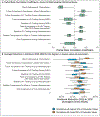What Will It Take to End HIV in the United States? : A Comprehensive, Local-Level Modeling Study
- PMID: 34543589
- PMCID: PMC8595759
- DOI: 10.7326/M21-1501
What Will It Take to End HIV in the United States? : A Comprehensive, Local-Level Modeling Study
Abstract
Background: The Ending the HIV Epidemic (EHE) initiative aims to reduce incident HIV infections by 90% over a span of 10 years. The intensity of interventions needed to achieve this for local epidemics is unclear.
Objective: To estimate the effect of HIV interventions at the city level.
Design: A compartmental model of city-level HIV transmission stratified by age, race, sex, and HIV risk factor was developed and calibrated.
Setting: 32 priority metropolitan statistical areas (MSAs).
Patients: Simulated populations in each MSA.
Intervention: Combinations of HIV testing and preexposure prophylaxis (PrEP) coverage among those at risk for HIV, plus viral suppression in persons with diagnosed HIV infection.
Measurements: The primary outcome was the projected reduction in incident cases from 2020 to 2030.
Results: Absent intervention, HIV incidence was projected to decrease by 19% across all 32 MSAs. Modest increases in testing (1.25-fold per year), PrEP coverage (5 percentage points), and viral suppression (10 percentage points) across the population could achieve reductions of 34% to 67% by 2030. Twenty-five percent PrEP coverage, testing twice a year on average, and 90% viral suppression among young Black and Hispanic men who have sex with men (MSM) achieved similar reductions (13% to 68%). Including all MSM and persons who inject drugs could reduce incidence by 48% to 90%. Thirteen of 32 MSAs could achieve greater than 90% reductions in HIV incidence with large-scale interventions that include heterosexuals. A web application with location-specific results is publicly available (www.jheem.org).
Limitation: The COVID-19 pandemic was not represented.
Conclusion: Large reductions in HIV incidence are achievable with substantial investment, but the EHE goals will be difficult to achieve in most locations. An interactive model that can help policymakers maximize the effect in their local environments is presented.
Primary funding source: National Institutes of Health.
Figures





Comment in
-
Ending HIV in the United States Will Require a Substantial Financial Commitment.Ann Intern Med. 2021 Nov;174(11):1620-1621. doi: 10.7326/M21-3607. Epub 2021 Sep 21. Ann Intern Med. 2021. PMID: 34543585 No abstract available.
Similar articles
-
Achieving the "Ending the HIV Epidemic in the U.S." incidence reduction goals among at-risk populations in the South.BMC Public Health. 2023 Apr 20;23(1):716. doi: 10.1186/s12889-023-15563-5. BMC Public Health. 2023. PMID: 37081482 Free PMC article.
-
Decreased Human Immunodeficiency Virus Diagnosis Rates Among Black and Hispanic or Latino Men Who Have Sex With Men in US Jurisdictions Supported by the THRIVE Demonstration Project, 2014-2019.Clin Infect Dis. 2023 Jan 13;76(2):307-314. doi: 10.1093/cid/ciac774. Clin Infect Dis. 2023. PMID: 36124683 Free PMC article.
-
Changes in HIV Preexposure Prophylaxis Awareness and Use Among Men Who Have Sex with Men - 20 Urban Areas, 2014 and 2017.MMWR Morb Mortal Wkly Rep. 2019 Jul 12;68(27):597-603. doi: 10.15585/mmwr.mm6827a1. MMWR Morb Mortal Wkly Rep. 2019. PMID: 31298662 Free PMC article.
-
The global response to HIV in men who have sex with men.Lancet. 2016 Jul 9;388(10040):198-206. doi: 10.1016/S0140-6736(16)30781-4. Lancet. 2016. PMID: 27411880 Review.
-
Applying a PrEP Continuum of Care for Men Who Have Sex With Men in Atlanta, Georgia.Clin Infect Dis. 2015 Nov 15;61(10):1590-7. doi: 10.1093/cid/civ664. Epub 2015 Aug 13. Clin Infect Dis. 2015. PMID: 26270691 Free PMC article. Review.
Cited by
-
Including transgender populations in mathematical models for HIV treatment and prevention: current barriers and policy implications.J Int AIDS Soc. 2024 Jun;27(6):e26304. doi: 10.1002/jia2.26304. J Int AIDS Soc. 2024. PMID: 38867431 Free PMC article.
-
Estimating the epidemiological impact of reaching the objectives of the Florida integrated HIV prevention and care plan in Miami-Dade County.Lancet Reg Health Am. 2023 Oct 25;27:100623. doi: 10.1016/j.lana.2023.100623. eCollection 2023 Nov. Lancet Reg Health Am. 2023. PMID: 37928440 Free PMC article.
-
Perspectives and experiences regarding pre-exposure prophylaxis (PrEP) in a community sample of Veterans with unhealthy alcohol use: overall and across sexual orientation and gender identity.Addict Sci Clin Pract. 2025 Jan 28;20(1):5. doi: 10.1186/s13722-024-00533-y. Addict Sci Clin Pract. 2025. PMID: 39876005 Free PMC article.
-
Impact of subgroup-specific heterogeneities and dynamic changes in mortality rates on forecasted population size, deaths, and age distribution of persons receiving antiretroviral treatment in the United States: a computer simulation study.Ann Epidemiol. 2023 Nov;87:S1047-2797(23)00171-0. doi: 10.1016/j.annepidem.2023.09.005. Epub 2023 Sep 22. Ann Epidemiol. 2023. PMID: 37741499 Free PMC article.
-
The future of HIV: challenges in meeting the 2030 Ending the HIV Epidemic in the US (EHE) reduction goal.AIDS. 2025 May 1;39(6):708-718. doi: 10.1097/QAD.0000000000004122. Epub 2025 Jan 16. AIDS. 2025. PMID: 39832182
References
-
- Centers for Disease Control and Prevention. Diagnoses of HIV infection in the United States and dependent areas, 2018 (updated). HIV Surveillance Report. 2020;31:1–119. Accessed at www.cdc.gov/hiv/pdf/library/reports/surveillance/cdc-hiv-surveillance-re... on 5/1/2021.
-
- Panagiotoglou D, Olding M, Enns B, et al.; Localized HIV Modeling Study Group. Building the case for localized approaches to HIV: structural conditions and health system capacity to address the HIV/AIDS epidemic in six US cities. AIDS Behav. 2018;22:3071–3082. doi:10.1007/s10461-018-2166-6 - DOI - PMC - PubMed
Publication types
MeSH terms
Substances
Grants and funding
LinkOut - more resources
Full Text Sources
Medical
Miscellaneous
